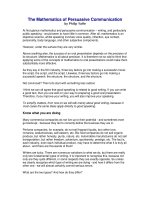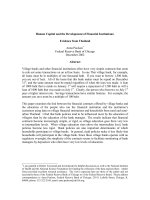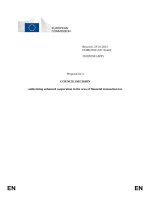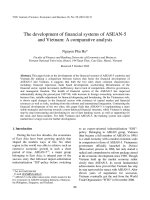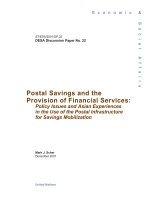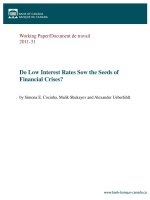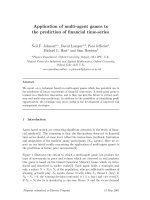the mathematics of financial modelling - fabozzi
Bạn đang xem bản rút gọn của tài liệu. Xem và tải ngay bản đầy đủ của tài liệu tại đây (11.43 MB, 801 trang )
Frontmatter Page i Monday, March 8, 2004 10:06 AM
The Mathematics of
Financial Modeling
and Investment
Management
SERGIO M. FOCARDI
FRANK J. FABOZZI
John Wiley & Sons, Inc.
Frontmatter Page ii Monday, March 8, 2004 10:06 AM
SMF
To Dominique, Leila, Guillaume, and Richard
FJF
To my beautiful wife Donna and my children,
Francesco, Patricia, and Karly
Copyright © 2004 by John Wiley & Sons, Inc. All rights reserved.
Published by John Wiley & Sons, Inc., Hoboken, New Jersey
Published simultaneously in Canada
No part of this publication may be reproduced, stored in a retrieval system, or transmitted in
any form or by any means, electronic, mechanical, photocopying, recording, scanning, or oth-
erwise, except as permitted under Section 107 or 108 of the 1976 United States Copyright
Act, without either the prior written permission of the Publisher, or authorization through
payment of the appropriate per-copy fee to the Copyright Clearance Center, Inc., 222 Rose
-
wood Drive, Danvers, MA 01923, 978-750-8400, fax 978-750-4470, or on the web at
www.copyright.com. Requests to the Publisher for permission should be addressed to the Per-
missions Department, John Wiley & Sons, Inc., 111 River Street, Hoboken, NJ 07030, 201-
748-6011, fax 201-748-6008.
Limit of Liability/Disclaimer of Warranty: While the publisher and author have used their best
efforts in preparing this book, they make no representations or warranties with respect to the
accuracy or completeness of the contents of this book and specifically disclaim any implied
warranties of merchantability or fitness for a particular purpose. No warranty may be created
or extended by sales representatives or written sales materials. The advice and strategies con-
tained herein may not be suitable for your situation. You should consult with a professional
where appropriate. Neither the publisher nor author shall be liable for any loss of profit or
any other commercial damages, including but not limited to special, incidental, consequential,
or other damages.
For general information on our other products and services, or technical support, please con-
tact our Customer Care Department within the United States at 800-762-2974, outside the
United States at 317-572-3993, or fax 317-572-4002.
Wiley also publishes its books in a variety of electronic formats. Some content that appears in
print may not be available in electronic books.
For more information about Wiley, visit our web site at www.wiley.com.
ISBN: 0-471-46599-2
Printed in the United States of America
10 9 8 7 6 5 4 3 2 1
Frontmatter Page iii Monday, March 8, 2004 10:06 AM
Contents
Preface xiv
Acknowledgments xvi
About the Authors xviii
Commonly Used Symbols
xix
Abbreviations and Acronyms xx
CHAPTER
1
From Art to Engineering in Finance 1
Investment Management Process 2
Step 1: Setting Investment Objectives 2
Step 2: Establishing an Investment Policy 2
Step 3: Selecting a Portfolio Strategy 6
Step 4: Selecting the Specific Assets 7
Step 5: Measuring and Evaluating Performance 9
Financial Engineering in Historical Perspective 10
The Role of Information Technology 11
Industry’s Evaluation of Modeling Tools 13
Integrating Qualitative and Quantitative Information 15
Principles for Engineering a Suite of Models 17
Summary 18
CHAPTER 2
Overview of Financial Markets, Financial Assets, and Market Participants 21
Financial Assets 21
Financial Markets 25
Classification of Financial Markets 25
Economic Functions of Financial Markets 26
Secondary Markets 27
Overview of Market Participants 34
Role of Financial Intermediaries 35
Institutional Investors 37
Insurance Companies 41
Pension Funds 41
Investment Companies 42
Depository Institutions 43
Endowments and Foundations 45
Common Stock 45
iii
Frontmatter Page iv Monday, March 8, 2004 10:06 AM
iv Contents
Trading Locations 45
Stock Market Indicators 46
Trading Arrangements 48
Bonds 51
Maturity 51
Par Value 52
Coupon Rate 52
Provisions for Paying off Bonds 55
Options Granted to Bondholders 56
Futures and Forward Contracts 57
Futures versus Forward Contracts 58
Risk and Return Characteristics of Futures Contracts 59
Pricing of Futures Contracts 59
The Role of Futures in Financial Markets 63
Options 64
Risk-Return for Options 66
The Option Price 66
Swaps 69
Caps and Floors 70
Summary 71
CHAPTER 3
Milestones in Financial Modeling and Investment Management 75
The Precursors: Pareto, Walras, and the Lausanne School 76
Price Diffusion: Bachelier 78
The Ruin Problem in Insurance: Lundberg 80
The Principles of Investment: Markowitz 81
Understanding Value: Modigliani and Miller 83
Modigliani-Miller Irrelevance Theorems and the
Absence of Arbitrage 84
Efficient Markets: Fama and Samuelson 85
Capital Asset Pricing Model: Sharpe, Lintner, and Mossin 86
The Multifactor CAPM: Merton 87
Arbitrage Pricing Theory: Ross 88
Arbitrage, Hedging, and Option Theory:
Black, Scholes, and Merton 89
Summary 90
CHAPTER 4
Principles of Calculus 91
Sets and Set Operations 93
Proper Subsets 93
Empty Sets 95
Union of Sets 95
Intersection of Sets 95
Elementary Properties of Sets 96
Distances and Quantities 96
n-tuples 97
Distance 98
Frontmatter Page v Monday, March 8, 2004 10:06 AM
v Contents
Density of Points 99
Functions 100
Variables 101
Limits 102
Continuity 103
Total Variation 105
Differentiation 106
Commonly Used Rules for Computing Derivatives 107
Higher Order Derivatives 111
Application to Bond Analysis 112
Taylor Series Expansion 121
Application to Bond Analysis 122
Integration 127
Riemann Integrals 127
Properties of Riemann Integrals 129
Lebesque-Stieltjes Integrals 130
Indefinite and Improper Integrals 131
The Fundamental Theorem of Calculus 132
Integral Transforms 134
Laplace Transform 134
Fourier Transforms 137
Calculus in More than One Variable 138
Summary 139
CHAPTER 5
Matrix Algebra 141
Vectors and Matrices Defined 141
Vectors 141
Matrices 144
Square Matrices 145
Diagonals and Antidiagonals 145
Identity Matrix 146
Diagonal Matrix 146
Upper and Lower Triangular Matrix 148
Determinants 148
Systems of Linear Equations 149
Linear Independence and Rank 151
Hankel Matrix 152
Vector and Matrix Operations 153
Vector Operations 153
Matrix Operations 156
Eigenvalues and Eigenvectors 160
Diagonalization and Similarity 161
Singular Value Decomposition 162
Summary 163
CHAPTER 6
Concepts of Probability 165
Representing Uncertainty with Mathematics 165
Probability in a Nutshell 167
Frontmatter Page vi Monday, March 8, 2004 10:06 AM
vi Contents
Outcomes and Events 169
Probability 170
Measure 171
Random Variables 172
Integrals 172
Distributions and Distribution Functions 174
Random Vectors 175
Stochastic Processes 178
Probabilistic Representation of Financial Markets 180
Information Structures 181
Filtration 182
Conditional Probability and Conditional Expectation 184
Moments and Correlation 186
Copula Functions 188
Sequences of Random Variables 189
Independent and Identically Distributed Sequences 191
Sum of Variables 191
Gaussian Variables 194
The Regression Function 197
Linear Regression 197
Summary 199
CHAPTER 7
Optimization 201
Maxima and Minima 202
Lagrange Multipliers 204
Numerical Algorithms 206
Linear Programming 206
Quadratic Programming 211
Calculus of Variations and Optimal Control Theory 212
Stochastic Programming 214
Summary 216
CHAPTER 8
Stochastic Integrals 217
The Intuition Behind Stochastic Integrals 219
Brownian Motion Defined 225
Properties of Brownian Motion 230
Stochastic Integrals Defined 232
Some Properties of Itô Stochastic Integrals 236
Summary 237
CHAPTER 9
Differential Equations and Difference Equations 239
Differential Equations Defined 240
Ordinary Differential Equations 240
Order and Degree of an ODE 241
Solution to an ODE 241
Systems of Ordinary Differential Equations 243
Frontmatter Page vii Monday, March 8, 2004 10:06 AM
Contents vii
Closed-Form Solutions of Ordinary Differential Equations 246
Linear Differential Equation 247
Numerical Solutions of Ordinary Differential Equations 249
The Finite Difference Method 249
Nonlinear Dynamics and Chaos 256
Fractals 258
Partial Differential Equations 259
Diffusion Equation 259
Solution of the Diffusion Equation 261
Numerical Solution of PDEs 263
Summary 265
CHAPTER 10
Stochastic Differential Equations 267
The Intuition Behind Stochastic Differential Equations 268
Itô Processes 271
The 1-Dimensional Itô Formula 272
Stochastic Differential Equations 274
Generalization to Several Dimensions 276
Solution of Stochastic Differential Equations 278
The Arithmetic Brownian Motion 280
The Ornstein-Uhlenbeck Process 280
The Geometric Brownian Motion 281
Summary 282
CHAPTER 11
Financial Econometrics: Time Series Concepts, Representations, and Models 283
Concepts of Time Series 284
Stylized Facts of Financial Time Series 286
Infinite Moving-Average and Autoregressive
Representation of Time Series 288
Univariate Stationary Series 288
The Lag Operator L 289
Stationary Univariate Moving Average 292
Multivariate Stationary Series 293
Nonstationary Series 295
ARMA Representations 297
Stationary Univariate ARMA Models 297
Nonstationary Univariate ARMA Models 300
Stationary Multivariate ARMA Models 301
Nonstationary Multivariate ARMA Models 304
Markov Coefficients and ARMA Models 304
Hankel Matrices and ARMA Models 305
State-Space Representation 305
Equivalence of State-Space and ARMA Representations 308
Integrated Series and Trends 309
Summary 313
Frontmatter Page viii Monday, March 8, 2004 10:06 AM
viii Contents
CHAPTER 12
Financial Econometrics: Model Selection, Estimation, and Testing 315
Model Selection 315
Learning and Model Complexity 317
Maximum Likelihood Estimate 319
Linear Models of Financial Time Series 324
Random Walk Models 324
Correlation 327
Random Matrices 329
Multifactor Models 332
CAPM 334
Asset Pricing Theory (APT) Models 335
PCA and Factor Models 335
Vector Autoregressive Models 338
Cointegration 339
State-Space Modeling and Cointegration 342
Empirical Evidence of Cointegration in Equity Prices 343
Nonstationary Models of Financial Time Series 345
The ARCH/GARCH Family of Models 346
Markov Switching Models 347
Summary 349
CHAPTER 13
Fat Tails, Scaling, and Stable Laws 351
Scaling, Stable Laws, and Fat Tails 352
Fat Tails 352
The Class L of Fat-Tailed Distributions 353
The Law of Large Numbers and the Central Limit Theorem 358
Stable Distributions 360
Extreme Value Theory for IID Processes 362
Maxima 362
Max-Stable Distributions 368
Generalized Extreme Value Distributions 368
Order Statistics 369
Point Process of Exceedances or Peaks over Threshold 371
Estimation 373
Eliminating the Assumption of IID Sequences 378
Heavy-Tailed ARMA Processes 381
ARCH/GARCH Processes 382
Subordinated Processes 383
Markov Switching Models 384
Estimation 384
Scaling and Self-Similarity 385
Evidence of Fat Tails in Financial Variables 388
On the Applicability of Extreme Value Theory in Finance 391
Summary 392
Frontmatter Page ix Monday, March 8, 2004 10:06 AM
ix Contents
CHAPTER 14
Arbitrage Pricing: Finite-State Models 393
The Arbitrage Principle 393
Arbitrage Pricing in a One-Period Setting 395
State Prices 397
Risk-Neutral Probabilities 398
Complete Markets 399
Arbitrage Pricing in a Multiperiod Finite-State Setting 402
Propagation of Information 402
Trading Strategies 403
State-Price Deflator 404
Pricing Relationships 405
Equivalent Martingale Measures 414
Risk-Neutral Probabilities 416
Path Dependence and Markov Models 423
The Binomial Model 423
Risk-Neutral Probabilities for the Binomial Model 426
Valuation of European Simple Derivatives 427
Valuation of American Options 429
Arbitrage Pricing in a Discrete-Time, Continuous-State Setting 430
APT Models 435
Testing APT 436
Summary 439
CHAPTER 15
Arbitrage Pricing: Continuous-State, Continuous-Time Models 441
The Arbitrage Principle in Continuous Time 441
Trading Strategies and Trading Gains 443
Arbitrage Pricing in Continuous-State, Continuous-Time 445
Option Pricing 447
Stock Price Processes 447
Hedging 448
The Black-Scholes Option Pricing Formula 449
Generalizing the Pricing of European Options 452
State-Price Deflators 454
Equivalent Martingale Measures 457
Equivalent Martingale Measures and Girsanov’s Theorem 459
The Diffusion Invariance Principle 461
Application of Girsanov’s Theorem to Black-Scholes
Option Pricing Formula 462
Equivalent Martingale Measures and Complete Markets 463
Equivalent Martingale Measures and State Prices 464
Arbitrage Pricing with a Payoff Rate 466
Implications of the Absence of Arbitrage 467
Working with Equivalent Martingale Measures 468
Summary 468
Frontmatter Page x Monday, March 8, 2004 10:06 AM
x Contents
CHAPTER 16
Portfolio Selection Using Mean-Variance Analysis 471
Diversification as a Central Theme in Finance 472
Markowitz’s Mean-Variance Analysis 474
Capital Market Line 477
Deriving the Capital Market Line 478
What is Portfolio M? 481
Risk Premium in the CML 482
The CML and the Optimal Portfolio 482
Utility Functions and Indifference Curves 482
Selection of the Optimal Portfolio 484
Extension of the Markowitz Mean-Variance Model to
Inequality Constraints 485
A Second Look at Portfolio Choice 487
The Return Forecast 487
The Utility Function 488
Optimizers 490
A Global Probabilistic Framework for Portfolio Selection 490
Relaxing the Assumption of Normality 491
Multiperiod Stochastic Optimization 492
Application to the Asset Allocation Decision 494
The Inputs 495
Portfolio Selection: An Example 500
Inclusion of More Asset Classes 503
Extensions of the Basic Asset Allocation Model 507
Summary 509
CHAPTER 17
Capital Asset Pricing Model 511
CAPM Assumptions 512
Systematic and Nonsystematic Risk 513
Security Market Line 516
Estimating the Characteristic Line 518
Testing The CAPM 518
Deriving the Empirical Analogue of the CML 518
Empricial Implications 519
General Findings of Empirical Tests of the CAPM 520
A Critique of Tests of the CAPM 520
Merton and Black Modifications of the CAPM 521
CAPM and Random Matrices 522
The Conditional CAPM 523
Beta, Beta Everywhere 524
The Role of the CAPM in Investment Management Applications 525
Summary 526
CHAPTER 18
Multifactor Models and Common Trends for Common Stocks 529
Multifactor Models 530
Determination of Factors 532
Frontmatter Page xi Monday, March 8, 2004 10:06 AM
xi Contents
Dynamic Market Models of Returns 537
Estimation of State-Space Models 538
Dynamic Models for Prices 538
Estimation and Testing of Cointegrated Systems 543
Cointegration and Financial Time Series 544
Nonlinear Dynamic Models for Prices and Returns 546
Summary 549
CHAPTER 19
Equity Portfolio Management 551
Integrating the Equity Portfolio Management Process 551
Active versus Passive Portfolio Management 552
Tracking Error 553
Backward-Looking versus Forward-Looking Tracking Error 555
The Impact of Portfolio Size, Benchmark Volatility, and
Portfolio Beta on Tracking Error 556
Equity Style Management 560
Types of Equity Styles 560
Style Classification Systems 562
Passive Strategies 564
Constructing an Indexed Portfolio 564
Index Tracking and Cointegration 565
Active Investing 566
Top-Down Approaches to Active Investing 566
Bottom-Up Approaches to Active Investing 567
Fundamental Law of Active Management 568
Strategies Based on Technical Analysis 571
Nonlinear Dynamic Models and Chaos 573
Technical Analysis and Statistical Nonlinear
Pattern Recognition 574
Market-Neutral Strategies and Statistical Arbitrage 575
Application of Multifactor Risk Models 577
Risk Decomposition 577
Portfolio Construction and Risk Control 582
Assessing the Exposure of a Portfolio 583
Risk Control Against a Stock Market Index 587
Tilting a Portfolio 587
Summary 589
CHAPTER 20
Term Structure Modeling and Valuation of Bonds and Bond Options 593
Basic Principles of Valuation of Debt Instruments 594
Yield-to-Maturity Measure 596
Premium Par Yield 598
Reinvestment of Cash Flow and Yield 598
The Term Structure of the Interest Rates and the Yield Curve 599
Limitations of Using the Yield to Value a Bond 602
Valuing a Bond as a Package of Cash Flows 603
Obtaining Spot Rates from the Treasury Yield Curve 603
Using Spot Rates to the Arbitrage-Free Value of a Bond 606
Frontmatter Page xii Monday, March 8, 2004 10:06 AM
xii Contents
The Discount Function 606
Forward Rates 607
Swap Curve 608
Classical Economic Theories About the Determinants of the
Shape of the Term Structure 612
Expectations Theories 613
Market Segmentation Theory 618
Bond Valuation Formulas in Continuous Time 618
The Term Structure of Interest Rates in Continuous Time 623
Spot Rates: Continuous Case 624
Forward Rates: Continuous Case 625
Relationships for Bond and Option Valuation 626
The Feynman-Kac Formula 627
Multifactor Term Structure Model 632
Arbitrage-Free Models versus Equilibrium Models 634
Examples of One-Factor Term Structure Models 635
Two-Factor Models 638
Pricing of Interest-Rate Derivatives 638
The Heath-Jarrow-Morton Model of the Term Structure 640
The Brace-Gatarek-Musiela Model 643
Discretization of Itô Processes 644
Summary 646
CHAPTER 21
Bond Portfolio Management 649
Management versus a Bond Market Index 649
Tracking Error and Bond Portfolio Strategies 651
Risk Factors and Portfolio Management Strategies 652
Determinants of Tracking Error 654
Illustration of the Multifactor Risk Model 654
Liability-Funding Strategies 661
Cash Flow Matching 664
Portfolio Immunization 667
Scenario Optimization 672
Stochastic Programming 673
Summary 677
CHAPTER 22
Credit Risk Modeling and Credit Default Swaps 679
Credit Default Swaps 679
Single-Name Credit Default Swaps 680
Basket Default Swaps 681
Legal Documentation 683
Credit Risk Modeling: Structural Models 683
The Black-Scholes-Merton Model 685
Geske Compound Option Model 690
Barrier Structural Models 694
Advantages and Drawbacks of Structural Models 696
Credit Risk Modeling: Reduced Form Models 696
Frontmatter Page xiii Monday, March 8, 2004 10:06 AM
Contents xiii
The Poisson Process 697
The Jarrow-Turnbull Model 698
Transition Matrix 703
The Duffie-Singleton Model 706
General Observations on Reduced Form Models 710
Pricing Single-Name Credit Default Swaps 710
General Framework 711
Survival Probability and Forward Default Probability:
A Recap 712
Credit Default Swap Value 713
No Need For Stochastic Hazard Rate or Interest Rate 716
Delivery Option in Default Swaps 716
Default Swaps with Counterparty Risk 717
Valuing Basket Default Swaps 718
The Pricing Model 718
How to Model Correlated Default Processes 722
Summary 734
CHAPTER 23
Risk Management 737
Market Completeness 738
The Mathematics of Market Completeness 739
The Economics of Market Completeness 742
Why Manage Risk? 744
Risk Models 745
Market Risk 745
Credit Risk 746
Operational Risk 746
Risk Measures 747
Risk Management in Asset and Portfolio Management 751
Factors Driving Risk Management 752
Risk Measurement in Practice 752
Getting Down to the Lowest Level 753
Regulatory Implications of Risk Measurement 754
Summary 755
INDEX 757
Frontmatter Page xiv Monday, March 8, 2004 10:06 AM
Preface
Since the pioneering work of Harry Markowitz in the 1950s, sophisti-
cated statistical and mathematical techniques have increasingly made
their way into finance and investment management. One might question
whether all this mathematics is justified, given the present state of eco
-
nomics as a science. However, a number of laws of economics and finance
theory with a bearing on investment management can be considered
empirically well established and scientifically sound. This knowledge can
be expressed only in the language of statistics and mathematics. As a
result, practitioners must now be familiar with a vast body of statistical
and mathematical techniques.
Different areas of finance call for different mathematics. Investment
management is primarily concerned with understanding hard facts about
financial processes. Ultimately the performance of investment manage
-
ment is linked to an understanding of risk and return. This implies the
ability to extract information from time series that are highly noisy and
appear nearly random. Mathematical models must be simple, but with a
deep economic meaning.
In other areas, the complexity of instruments is the key driver behind
the growing use of sophisticated mathematics in finance. There is the need
to understand how relatively simple assumptions on the probabilistic behav
-
ior of basic quantities translate into the potentially very complex probabilis-
tic behavior of financial products. Derivatives are the typical example.
This book is designed to be a working tool for the investment man-
agement practitioner, student, and researcher. We cover the process of
financial decision-making and its economic foundations. We present
financial models and theories, including CAPM, APT, factor models,
models of the term structure of interest rates, and optimization method
-
ologies. Special emphasis is put on the new mathematical tools that
allow a deeper understanding of financial econometrics and financial
economics. For example, tools for estimating and representing the tails
of the distributions, the analysis of correlation phenomena, and dimen
-
sionality reduction through factor analysis and cointegration are recent
advances in financial economics that we discuss in depth.
xiv
Frontmatter Page xv Monday, March 8, 2004 10:06 AM
Preface xv
Special emphasis has been put on describing concepts and mathe-
matical techniques, leaving aside lengthy demonstrations, which, while
the substance of mathematics, are of limited interest to the practitioner
and student of financial economics. From the practitioner’s point of
view, what is important is to have a firm grasp of the concepts and tech
-
niques, which will allow one to interpret the results of simulations and
analyses that are now an integral part of finance.
There is no prerequisite mathematical knowledge for reading this
book: all mathematical concepts used in the book are explained, starting
from ordinary calculus and matrix algebra. It is, however, a demanding
book given the breadth and depth of concepts covered. Mathematical
concepts are in bolded type when they appear for the first time in the
book, economic and finance concepts are italicized when they appear for
the first time.
In writing this book, special attention was given to bridging the gap
between the intuition of the practitioner and academic mathematical
analysis. Often there are simple compelling reasons for adopting sophisti-
cated concepts and techniques that are obscured by mathematical details;
whenever possible, we tried to give the reader an understanding of the
reasoning behind these concepts. The book has many examples of how
quantitative analysis is used in practice. These examples help the reader
appreciate the connection between quantitative analysis and financial
decision-making. A distinctive feature of this book is the integration of
notions deeply rooted in the practice of investment management with
methods based on finance theory and statistical analysis.
Sergio M. Focardi
Frank J. Fabozzi
Frontmatter Page xvi Monday, March 8, 2004 10:06 AM
Acknowledgments
We are grateful to Professor Ren-Raw Chen of Rutgers University for coau-
thoring Chapter 22 (“Credit Risk Modeling and Credit Default Swaps”).
The application of mean-variance analysis to asset allocation in
Chapter 16 is from the coauthored work of Frank Fabozzi with Harry
Markowitz and Francis Gupta. The discussion of tracking error and risk
decomposition in Chapter 18 draws from the coauthored work of Frank
Fabozzi with Frank Jones and Raman Vardharaj.
In writing a book that covers a wide range of technical topics in
mathematics and finance, we were fortunate enough to receive assistance
from the following individuals:
■ Caroline Jonas of The Intertek Group read and commented on most
chapters in the book.
■ Dr. Petter Kolm of Goldman Sachs Asset Management reviewed Chap-
ters 4, 6, 7, 9, and 20.
■ Dr. Bernd Hanke of Goldman Sachs Asset Management reviewed
Chapters 14, 15, and 16.
■ Dr. Lisa Goldberg of Barra reviewed Chapter 13.
■ Professor Martijn Cremers of Yale University reviewed the first draft of
the financial econometrics material.
■ Hafize Gaye Erkan, a Post-General Ph.D. Candidate in the Department
of Operations Research and Financial Engineering at Princeton Univer-
sity, reviewed the chapters on stochastic calculus (Chapters 8 and 10).
■ Professor Antti Petajisto of Yale University reviewed Chapter 14.
■ Dr. Christopher Maloney of Citigroup reviewed Chapter 5.
■ Dr. Marco Raberto of the University of Genoa reviewed Chapter 13
and provided helpful support for the preparation of illustrations.
■ Dr. Mehmet Gokcedag of the Istanbul Bilgi University reviewed Chapter
22 and provided helpful comments on the organization and structure of
the book.
■ Professor Silvano Cincotti of the University of Genoa provided insight-
ful comments on a range of topics.
xvi
Frontmatter Page xvii Monday, March 8, 2004 10:06 AM
xviiAcknowledgments
■ Dr. Lev Dynkin and members of the Fixed Income Research Group at
Lehman Brothers reviewed Chapter 21.
■ Dr. Srichander Ramaswamy of the Bank for International Settlement
prepared the illustration in Chapter 13 to show the importance of fat-
tailed processes in credit risk management based on his book Manag
-
ing Credit Risk in Corporate Bond Portfolios: A Practitioner’s Guide.
■ Hemant Bhangale of Morgan Stanley reviewed Chapter 23.
Finally, Megan Orem typeset the book and provided editorial assis-
tance. We appreciate her patience and understanding in working through
several revisions of the chapters and several reorganizations of the table
of contents.
Frontmatter Page xviii Monday, March 8, 2004 10:06 AM
About the Authors
Sergio Focardi is a founding partner of the Paris-based consulting firm The
Intertek Group. Sergio lectures at CINEF (Center for Interdisciplinary
Research in Economics and Finance) at the University of Genoa and is a
member of the Editorial Board of the Journal of Portfolio Management. He
has published numerous articles on econophysics and coauthored two
books, Modeling the Markets: New Theories and Techniques and Risk Manage
-
ment: Framework, Methods and Practice. His research interests include
modeling the interaction between multiple heterogeneous agents and the
econometrics of large equity portfolios based on cointegration and dynamic
factor analysis. Sergio holds a degree in Electronic Engineering from the
University of Genoa and a postgraduate degree in Communications from
the Galileo Ferraris Electrotechnical Institute (Turin).
Frank J. Fabozzi, Ph.D., CFA, CPA is the Frederick Frank Adjunct Profes-
sor of Finance in the School of Management at Yale University. Prior to
joining the Yale faculty, he was a Visiting Professor of Finance in the Sloan
School of Management at MIT. Frank is a Fellow of the International Cen
-
ter for Finance at Yale University, the editor of the Journal of Portfolio
Management, a member of Princeton University’s Advisory Council for the
Department of Operations Research and Financial Engineering, and a
trustee of the BlackRock complex of closed-end funds and Guardian Life
sponsored open-end mutual funds. He has authored several books in
investment management and in 2002 was inducted into the Fixed Income
Analysts Society’s Hall of Fame. Frank earned a doctorate in economics
from the City University of New York in 1972.
xviii
Frontmatter Page xix Monday, March 8, 2004 10:06 AM
Commonly Used Symbols
A(L) polynomial in the lag operator L
β k-vector [β
1
β
k
]′
∆ difference operator
ε
t
error, usually white noise
⋅ vector scalar product x ⋅ y also written xy
+ sum of vector or matrices A + B
T
transpose of a vector or matrix A
T
adj adjoint of a matrix
|A| determinant of a matrix
B Borel σ-algebra
ℑ Filtration
R
α
regularly varying functions of index α
∪ union of sets
∩ intersection of sets
∈ belongs to
∉ does not belong to
→ tends to
summation with implicit range
∑
N
∑
summation over range shown
i = 1
product with implicit range
∏
N
∏
product over range shown
i = 1
Φ(x) cdf of the standardized normal
Ω sample space
E[X] expectation
E[X|Z] conditional expectation
xix
Frontmatter Page xx Monday, March 8, 2004 10:06 AM
Abbreviations and Acronyms
ABS asset-backed securities
ADF augmented Dickey-Fuller
a.e. almost everywhere
AIC Akaike information criterion
AMEX American Stock Exchange
APT asset pricing theory
AR auto regressive
ARCH autoregressive conditional heteroschedastic
ARDL auto regressive distributed lag
ARIMA auto regressive integrated moving average
ARMA auto regressive moving average
a.s. almost surely
ASE American Stock Exchange
BET bond equivalent yield
BGM Brace-Gatarek-Musiela model
BIC Bayesian information criterion
CAPM capital asset pricing model
C(CAPM) conditional capital asset pricing model
CD certificate of deposit
CFM cash flow matching
CFTC Commodity Futures Trading Commission
CLT central limit theorem
CML capital market line
CrVaR credit risk value-at-risk
CvaR conditional value-at-risk
DAX Geman stock index
d.f (cumulative) distribution functions
DF Dickey-Fuller
DGP data generation process
DJIA Dow Jones Industrial Average
xx
Frontmatter Page xxi Monday, March 8, 2004 10:06 AM
xxi
L
Abbreviations and Acronyms
EAFE Index Europe, Australia, and Far East Index
EC error correction
ECM error correction model
ECN electronic communication network
EM expectation maximization
ERISA Employee Retirement Income Security Act
ES expected shortfall
ESR expected shortfall risk
EVT extreme value theory
FLOPS floating point operations per second
GAAP generally accepted accounting principles
GARCH generalized autoregressive conditional heteroschedastic
GET general equilibrium theory
GEV generalized extreme value
GMM generalized method of moments
GNP gross national product
HFD high frequency data
HJM Heath, Jarrow, Morton model
IC information criteria
IGRACH integrated GARCH
IID independent and identically distributed
IIN independent identically normal
IN independent normal
IR information ratio
ISO International Standards Organization
lag operator
LIBOR London Interbank Offered Rate
LLN law of large numbers
LP linear program, linear programming
MA moving average
MDA maximum domain of attraction
MBS mortgage-backed securities
MIP mixed integer programming
ML maximum likelihood
MLE maximum likelihood estimator
MPT modern portfolio theory
MSCI Morgan Stanley Composite Index
Frontmatter Page xxii Monday, March 8, 2004 10:06 AM
xxii Abbreviations and Acronyms
MSCI-EM Morgan Stanley Composite Index-Emerging Markets
MSCI-EME Morgan Stanley Composite Index-Emerging Markets
Equity
M-V analysis mean-variance analysis
NASDAQ National Association of Securities Dealers Automated
Quotation System
NAV net asset value
NYSE New York Stock Exchange
ODE ordinary differential equation
OLS ordinary least squares
OTC over-the-counter
P/B price-to-book ratio
P&C property & casualty
PCA principal component analysis
PDE partial differential equation
pdf probability density function
QP quadratic program, quadratic programming
RAP regulatory accounting principles
RDF resource description framework
RMT random matrix theory
ROI return on investment
SDE stochastic differential equation
S&L savings & loan
S&P 500 Standard & Poor’s 500 Index
SML security market line
ss self similar
SSB BIG Index Salomon Smith Barney Broad Investment Grade Index
sssi self similar with stationary increments
UL unexpected loss
VaR value-at-risk
VAR vector auto regressive
VC theory Vapnik-Chervonenkis theory
VLCA Value Line Composite Average
XML eXtensible markup language
1-Art to Engineering Page 1 Wednesday, February 4, 2004 12:38 PM
I
CHAPTER
1
From Art to Engineering in
Finance
t is often said that investment management is an art, not a science.
However since early 1990s the market has witnessed a progressive
shift towards a more industrial view of the investment management pro-
cess. There are several reasons for this change. First, with globalization
the universe of investable assets has grown many times over. Asset man-
agers might have to choose from among several thousand possible
investments from around the globe. The S&P 500 index is itself chosen
from a pool of 8,000 investable U.S. stocks. Second, institutional inves
-
tors, often together with their investment consultants, have encouraged
asset management firms to adopt an increasingly structured process
with documented steps and measurable results. Pressure from regulators
and the media is another factor. Lastly, the sheer size of the markets
makes it imperative to adopt safe and repeatable methodologies. The
volumes are staggering. With the recent growth of the world’s stock
markets, total market capitalization is now in the range of tens of tril
-
lions of dollars
1
while derivatives held by U. S. commercial banks
topped $65.8 trillion in the second quarter of 2003.
2
1
Exact numbers are difficult to come up with as information about many markets is
missing and price fluctuations remain large.
2
Office of the Comptroller of the Currency, Quarterly Derivatives Report, Second
Quarter 2003.
1
1-Art to Engineering Page 2 Wednesday, February 4, 2004 12:38 PM
2 The Mathematics of Financial Modeling and Investment Management
INVESTMENT MANAGEMENT PROCESS
The investment management process involves the following five steps:
Step 1: Setting investment objectives
Step 2: Establishing an investment policy
Step 3: Selecting an investment strategy
Step 4: Selecting the specific assets
Step 5: Measuring and evaluating investment performance
The overview of the investment management process described below
should help in understanding the activities that the portfolio manager
faces and the need for the analytical tools that are described in the chap
-
ters that follow in this book.
Step 1: Setting Investment Objectives
The first step in the investment management process, setting investment
objectives, begins with a thorough analysis of the investment objectives
of the entity whose funds are being managed. These entities can be clas
-
sified as individual investors and institutional investors. Within each of
these broad classifications is a wide range of investment objectives.
The objectives of an individual investor may be to accumulate funds
to purchase a home or other major acquisitions, to have sufficient funds to
be able to retire at a specified age, or to accumulate funds to pay for col
-
lege tuition for children. An individual investor may engage the services of
a financial advisor/consultant in establishing investment objectives.
In Chapter 3 we review the different types of institutional investors.
We will also see that in general we can classify institutional investors into
two broad categories—those that must meet contractually specified liabil
-
ities and those that do not. We can classify those in the first category as
institutions with “liability-driven objectives” and those in the second cat-
egory as institutions with “nonliability driven objectives.” Some institu-
tions have a wide range of investment products that they offer investors,
some of which are liability driven and others that are nonliability driven.
Once the investment objective is understood, it will then be possible to (1)
establish a “benchmark” or “bogey” by which to evaluate the performance
of the investment manager and (2) evaluate alternative investment strate
-
gies to assess the potential for realizing the specified investment objective.
Step 2: Establishing an Investment Policy
The second step in the investment management process is establishing
policy guidelines to satisfy the investment objectives. Setting policy
